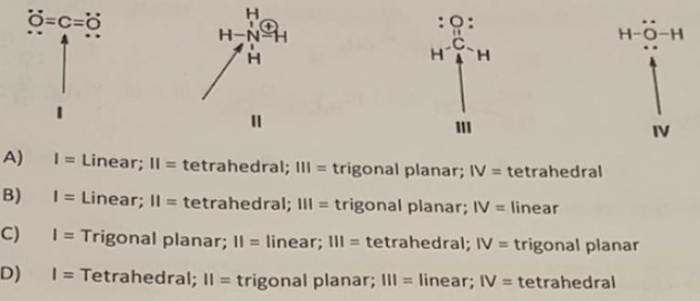Determine the geometry around the indicated atom in each species, delving into the captivating realm of molecular geometry, where the arrangement of atoms within molecules unveils a treasure trove of insights into their properties and behavior.
This exploration embarks on a journey through the fundamental concepts of electron-pair geometry and molecular geometry, unraveling the intricacies of molecular architecture and its profound impact on various aspects of chemistry.
1. Introduction: Determine The Geometry Around The Indicated Atom In Each Species
Molecular geometry refers to the spatial arrangement of atoms within a molecule. It plays a crucial role in understanding the molecule’s properties, reactivity, and interactions with other molecules.
Molecular geometry is determined by the electron-pair geometry, which describes the arrangement of electron pairs around the central atom. The electron-pair geometry is influenced by the number of valence electrons, lone pairs, and bonding pairs.
2. Determining Molecular Geometry

The molecular geometry of a species can be determined using the following steps:
- Count the total number of valence electrons.
- Determine the number of bonding pairs and lone pairs.
- Use the VSEPR (Valence Shell Electron Pair Repulsion) model to predict the electron-pair geometry.
- Based on the electron-pair geometry, determine the molecular geometry.
The VSEPR model predicts the electron-pair geometry based on the repulsion between electron pairs. The model assumes that electron pairs will arrange themselves in a way that minimizes repulsion, resulting in specific molecular geometries.
3. Molecular Geometry and Properties

Molecular geometry has a significant impact on the physical properties of a molecule, such as:
- Polarity:Polar molecules have a separation of charge, which is influenced by the molecular geometry.
- Boiling point:Molecules with more compact geometries have stronger intermolecular forces, resulting in higher boiling points.
- Solubility:Molecular geometry affects the ability of molecules to dissolve in different solvents.
Molecular geometry also influences the reactivity of molecules. For example, linear molecules are more reactive than bent molecules because the linear geometry allows for better overlap of orbitals during reactions.
4. Advanced Topics in Molecular Geometry

In addition to the VSEPR model, more advanced concepts are used to understand molecular geometry, including:
- Hybridization:Hybridization involves the mixing of atomic orbitals to form new hybrid orbitals with different shapes and energies.
- Resonance:Resonance occurs when a molecule can be represented by multiple Lewis structures, resulting in a hybrid structure with an intermediate geometry.
Computational methods are also used to determine molecular geometry more accurately. These methods involve solving the Schrödinger equation to obtain the wave function of the molecule, which provides information about the electron distribution and molecular geometry.
5. Applications of Molecular Geometry

Molecular geometry finds applications in various fields, including:
- Chemistry:Understanding molecular geometry is essential for predicting the properties and reactivity of molecules.
- Biology:Molecular geometry plays a role in protein folding, enzyme catalysis, and drug design.
- Materials science:Molecular geometry is important for designing materials with specific properties, such as strength, conductivity, and optical properties.
By understanding molecular geometry, scientists can develop new materials, drugs, and technologies that improve our lives.
FAQs
What is the significance of molecular geometry?
Molecular geometry plays a pivotal role in determining various physical and chemical properties of molecules, including polarity, boiling point, solubility, and reactivity.
How does molecular geometry affect molecular properties?
Molecular geometry influences the distribution of electrons within a molecule, which in turn affects its polarity, intermolecular forces, and reactivity.
What are the limitations of the VSEPR model?
While the VSEPR model provides a valuable tool for predicting molecular geometry, it has limitations in accurately predicting the geometry of molecules with resonance structures or those involving d-orbitals.